Windthrow Dynamics in Boreal Ontario: A Simulation of the Vulnerability of Several Stand Types across a Range of Wind Speeds
Abstract
:1. Introduction
2. Methodology
2.1. Overview of Modelling and Simulation Steps
2.2. Data Acquisition
2.3. Data Preparation
2.4. Data Classification
2.4.1. Stand Type Grouping
2.4.2. Stand Height Classification
2.5. Simulation and Analysis
2.5.1. Model Framework
2.5.2. Simulation Space
2.5.3. Estimating Resistive and Applied Moments
2.5.4. Synthesizing Damage Outcomes
2.5.5. Evaluating Damage Outcomes
3. Results
3.1. Windthrow Damage Outcomes
3.2. Generalizing Windthrow Simulations
3.3. Evaluating Model Simulation Outcomes
4. Discussion
5. Conclusions
Supplementary Materials
Acknowledgments
Author Contributions
Conflicts of Interest
References
- Wong, C.; Dorner, B.; Sandmann, H. Estimating Historical Variability of Natural Disturbances in British Columbia; British Columbia Ministry Sustainable Resource Management: Victoria, BC, Canada, 2003; p. 141.
- Landres, P.B.; Morgan, P.; Swanson, F.J. Overview of the use of natural variability concepts in managing ecological systems. Ecol. Appl. 1999, 9, 1179–1188. [Google Scholar]
- Montgomery, D.R. Process domains and the river continuum. J. Am. Water Res. Assoc. 1999, 35, 397–410. [Google Scholar] [CrossRef]
- Drever, C.R.; Peterson, G.; Messier, C.; Bergeron, Y.; Flannigan, M. Can forest management based on natural disturbances maintain ecological resilience? Can. J. For. Res. 2005, 36, 2285–2299. [Google Scholar] [CrossRef]
- Crow, T.R.; Perera, P.H. Emulating natural landscape disturbance in forest management—An introduction. In Emulating Natural Forest Landscape Disturbances: Concepts and Applications; Columbia University Press: New York, NY, USA, 2004; pp. 43–54. [Google Scholar]
- Franklin, J.F.; Spies, T.A.; Van Pelt, R.; Carey, A.B.; Thornburgh, D.A.; Berg, D.R.; Lindenmayer, D.B.; Harmon, M.E.; Keeton, W.S.; Shaw, D.C.; et al. Disturbances and structural development of natural forest ecosystems with silvicultural implications, using Douglas-fir forests as an example. For. Ecol. Manag. 2002, 155, 399–423. [Google Scholar] [CrossRef]
- Lindenmayer, D.B.; Franklin, J.F.; Fischer, J. General management principles and a checklist of strategies to guide forest biodiversity conservation. Biol. Conserv. 2006, 131, 433–445. [Google Scholar] [CrossRef]
- Dale, V.H.; Joyce, L.A.; McNulty, S.; Neilson, R.P.; Ayres, M.P.; Flannigan, M.D.; Hanson, P.J.; Irland, L.C.; Lugo, A.E.; Peterson, C.J.; et al. Climate change and forest disturbances: Climate change can affect forests by altering the frequency, intensity, duration, and timing of fire, drought, introduced species, insect and pathogen outbreaks, hurricanes, windstorms, ice storms, or landslides. BioScience 2001, 51, 723–734. [Google Scholar] [CrossRef]
- Pielke, R.A.; Pielke, R.A. Hurricanes, Their Nature and Impacts on Society; John Wiley and Sons: West Sussex, UK, 2007; p. 301. [Google Scholar]
- Blake, E.S.; Kimberlain, T.B.; Berg, R.J.; Cangialosi, J.P.; Beven, J.L., II. Tropical Cyclone Report: Hurricane Sandy; Nat Hurricane Center: Miami, FL, USA, 2013; Volume 12, pp. 1–10.
- Doswell, C.A., III. Severe Convective Storms; American Meteorological Society: Washington, DC, USA, 2001; p. 561. [Google Scholar]
- Mitchell, S.J. Wind as a natural disturbance agent in forests: A synthesis. Forestry 2013, 86, 147–157. [Google Scholar] [CrossRef]
- Anyomi, K.A.; Mitchell, S.J.; Ruel, J.-C. Windthrow modelling in old-growth and multi-layered boreal forests. Ecol. Mod. 2016, 327, 105–114. [Google Scholar] [CrossRef]
- Waldron, K.; Ruel, J.C.; Gauthier, S. The effects of site characteristics on the landscape-level windthrow regime in the North Shore region of Quebec, Canada. Forestry 2013, 86, 159–171. [Google Scholar] [CrossRef]
- Achim, A.; Ruel, J.-C.; Gardiner, B.A.; Laflamme, G.; Meunier, S. Modelling the vulnerability of balsam fir forests to wind damage. For. Ecol. Manag. 2005, 204, 35–50. [Google Scholar] [CrossRef]
- Peterson, C.J. Consistent influence of tree diameter and species on damage in nine eastern North America tornado blowdowns. For. Ecol. Manag. 2007, 250, 96–108. [Google Scholar] [CrossRef]
- Zeng, H.; Peltola, H.; Talkkari, A.; Strandman, H.; Venäläinen, A.; Wang, K.; Kellomäki, S. Simulations of the influence of clear-cutting on the risk of wind damage on a regional scale over a 20-year period. Can. J. For. Res. 2006, 36, 2247–2258. [Google Scholar] [CrossRef]
- Seidl, R.; Rammer, W.; Blennow, K. Simulating wind disturbance impacts on forest landscapes: Tree-level heterogeneity matters. Env. Mod. Softw. 2014, 51, 1–11. [Google Scholar] [CrossRef]
- Byrne, K.E.; Mitchell, S.J. Testing of WindFIRM/ForestGALES_BC: A hybrid-mechanistic model for predicting windthrow in partially harvested stands. Forestry 2013, 86, 185–199. [Google Scholar] [CrossRef]
- Hong, H.P.; Ye, W. Estimating extreme wind speed based on regional frequency analysis. Struct. Saf. 2013, 47, 67–77. [Google Scholar] [CrossRef]
- Sharma, M.; Parton, J.; Woods, M.; Newton, P.; Penner, M.; Wang, J.; Stinson, A.; Bell, F.W. Ontario’s forest growth and yield modelling program: Advances resulting from the Forestry Research Partnership. For. Chron. 2008, 84, 694–703. [Google Scholar] [CrossRef]
- Boucher, D.; Gauthier, S.; De Grandpré, L. Structural changes in coniferous stands along a chronosequence and a productivity gradient in the northeastern boreal forest of Québec. Ecoscience 2006, 13, 172–180. [Google Scholar] [CrossRef]
- Xi, W.; Peet, R.K.; Decoster, J.K.; Urban, D.L. Tree damage risk factors associated with large, infrequent wind disturbances of Carolina forests. Forestry 2008, 81, 317–334. [Google Scholar] [CrossRef]
- Anyomi, K. A.; Ruel, J.-C. A multi-scale analysis of the effects of alternative silvicultural treatments on windthrow within balsam fir dominated stands. Can. J. For. Res. 2015, 45, 1739–1747. [Google Scholar] [CrossRef]
- Rich, R.L.; Frelich, L.E.; Reich, P.B. Wind-throw mortality in the southern Boreal forest: Effects of species, diameter and stand age. J. Ecol. 2007, 95, 1261–1273. [Google Scholar] [CrossRef]
- Ulanova, N.G. The effects of windthrow on forests at different spatial scales: A review. For. Ecol. Manag. 2000, 135, 155–167. [Google Scholar] [CrossRef]
- Canham, C.D.; Papaik, M.J.; Latty, E.F. Interspecific variation in susceptibility to windthrow as a function of tree size and storm severity for northern temperate tree species. Can. J. For. Res. 2001, 31, 1–10. [Google Scholar] [CrossRef]
- Nolet, P.; Doyon, F.; Bouffard, D. Predicting stem windthrow probability in a northern hardwood forest using a wind intensity bio-indicator approach. Open J. For. 2012, 2, 77. [Google Scholar] [CrossRef]
- Kamimura, K.; Gardiner, B.; Dupont, S.; Guyon, D.; Meredieu, C. Mechanistic and statistical approaches to predicting wind damage to individual maritime pine (Pinus pinaster) trees in forests. Can. J. For. Res. 2015, 46, 88–100. [Google Scholar] [CrossRef]
- Hale, S.E.; Gardiner, B.; Peace, A.; Nicoll, B.; Taylor, P.; Pizzirani, S. Comparison and validation of three versions of a forest wind risk model. Environ. Mod. Softw. 2015, 68, 27–41. [Google Scholar] [CrossRef]
- Kamimura, K.; Gardiner, B.A.; Koga, S. Observations and predictions of wind damage to Larix kaempferi trees following thinning at an early growth stage. For. Int. J. For. Res. 2017, 201, 1–11. [Google Scholar]
- Kulakowski, D.; Matthews, C.; Jarvis, D.; Veblen, T.T. Compounded disturbances in sub-alpine forests in western Colorado favour future dominance by quaking aspen (Populus tremuloides). J. Veg. Sci. 2013, 24, 168–176. [Google Scholar] [CrossRef]
- Tang, G.; Beckage, B.; Smith, B. The potential transient dynamics of forests in New England under historical and projected future climate change. Clim. Chang. 2012, 114, 357–377. [Google Scholar] [CrossRef]
- Seidl, R.; Thom, D.; Kautz, M.; Martin-Benito, D.; Peltoniemi, M.; Vacchiano, G.; Wild, J.; Ascoli, D.; Petr, M.; Honkaniemi, J.; et al. Forest disturbances under climate change. Nat. Clim. Chang. 2017, 7, 395–402. [Google Scholar] [CrossRef]
- Ruel, J.-C.; Pineau, M. Windthrow as an important process for white spruce regeneration. For. Chang. 2002, 78, 732–738. [Google Scholar] [CrossRef]
- Plotkin, A.B.; Foster, D.; Carlson, J.; Magill, A. Survivors, not invaders, control forest development following simulated hurricane. Ecology 2013, 94, 414–423. [Google Scholar] [CrossRef] [PubMed]
- Kull, S.J.; Rampley, G.J.; Morken, S.; Metsaranta, J.M.; Neilson, E.T.; Kurz, W.A. Operational-Scale Carbon Budget Model of the Canadian Forest Sector (CBM-CFS3) Version 1.2: User’s Guide; Natural Resources Canada; Canadian Forest Service, Northern Forestry Centre: Edmonton, AB, Canada, 2014. [Google Scholar]
- Fortin, M.; Albrecht, A.; Kohnle, U.; Ningre, F. The impact of windstorm damage in the assessment of the carbon balance in even-aged Fagus sylvatica L. stands. Forests 2014, 5, 784–801. [Google Scholar] [CrossRef]
- Blennow, K.; Andersson, M.; Bergh, J.; Sallnäs, O.; Olofsson, E. Potential climate change impacts on the probability of wind damage in a south Swedish forest. Clim. Chang. 2010, 99, 261–278. [Google Scholar] [CrossRef]
- Peltola, H.; Ikonen, V-P.; Gregow, H.; Strandman, H.; Kilpeläinen, A.; Venäläinen, A.; Kellomäki, S. Impacts of climate change on timber production and regional risks of wind-induced damage to forests in Finland. For. Ecol. Manag. 2010, 260, 833–845. [Google Scholar] [CrossRef]
- Perera, A.H.; Dalziel, B.D.; Buse, L.J.; Routledge, R.G. Spatial variability of stand-scale residuals in Ontario’s boreal forest fires. Can. J. For. Res. 2009, 39, 945–961. [Google Scholar] [CrossRef]
- Gardiner, B.; Byrne, K.; Hale, S.; Kamimura, K.; Mitchell, S.J.; Peltola, H.; Ruel, J.C. A review of mechanistic modelling of wind damage risk to forests. Forestry 2008, 81, 447–463. [Google Scholar] [CrossRef]
- Bergeron, C.; Ruel, J.C.; Élie, J.G.; Mitchell, S.J. Root anchorage and stem strength of black spruce (Picea mariana) trees in regular and irregular stands. Forestry 2009, 82, 29–41. [Google Scholar] [CrossRef]
- Luther, J.E.; Skinner, R.; Fournier, R.A.; van Lier, O.R.; Bowers, W.W.; Coté, J.F.; Hopkinson, C.; Moulton, T. Predicting wood quantity and quality attributes of balsam fir and black spruce using airborne laser scanner data. Forestry 2013, 87, 313–326. [Google Scholar] [CrossRef]
- Ruel, J.-C.; Quine, C.P.; Meunier, S.; Suarez, J. Estimating windthrow risk in balsam fir stands with the ForestGales model. For. Chron. 2000, 76, 329–337. [Google Scholar] [CrossRef]
- Ter-Mikaelian, M.T.; Korzukhin, M.D. Biomass equations for sixty-five North American tree species. For. Ecol. Manag. 1997, 97, 1–24. [Google Scholar] [CrossRef]
- Seely, O. Physical Properties of Common Woods. 2007. Available online: http://www.csudh.edu/oliver/chemdata/woods.htm (accessed on 25 October 2016).
- Russell, M.B.; Weiskittel, A.R. Maximum and Largest Crown Width Equations for 15 Tree Species in Maine. North J. Appl. For. 2011, 28, 84–91. [Google Scholar]
- Elie, J.-G.; Ruel, J.-C. Windthrow hazard modelling in boreal forests of black spruce and Jack pine. Can. J. For. Res. 2005, 35, 2655–2663. [Google Scholar] [CrossRef]
- Pinno, B.D.; Lieffers, V.J.; Stadt, K.J. Measuring and modelling the crown and light transmission characteristics of juvenile aspen. Can. J. For. Res. 2001, 31, 1930–1939. [Google Scholar] [CrossRef]
- Manitoba Conservation and Water Stewardship (MCWS). Wood Supply Analysis Report for FMU 24. 105p. Available online: http://www.manitoba.ca/conservation/forestry/pdf/wood-supply/pineland_wood_supply_analysis_report_2013.pdf. (accessed on 8 January 2015).
- Vollsinger, S.; Mitchell, S.J.; Byrne, K.E.; Novak, M.D.; Rudnicki, M. Wind tunnel measurements of crown streamlining and drag relationships for several hardwood species. Can. J. For. Res. 2005, 35, 1238–1249. [Google Scholar] [CrossRef]
- Nicoll, B.C.; Gardiner, B.A.; Rayner, B.; Peace, A.J. Anchorage of coniferous trees in relation to species, soil type, and rooting depth. Can. J. For. Res. 2006, 36, 1871–1883. [Google Scholar] [CrossRef]
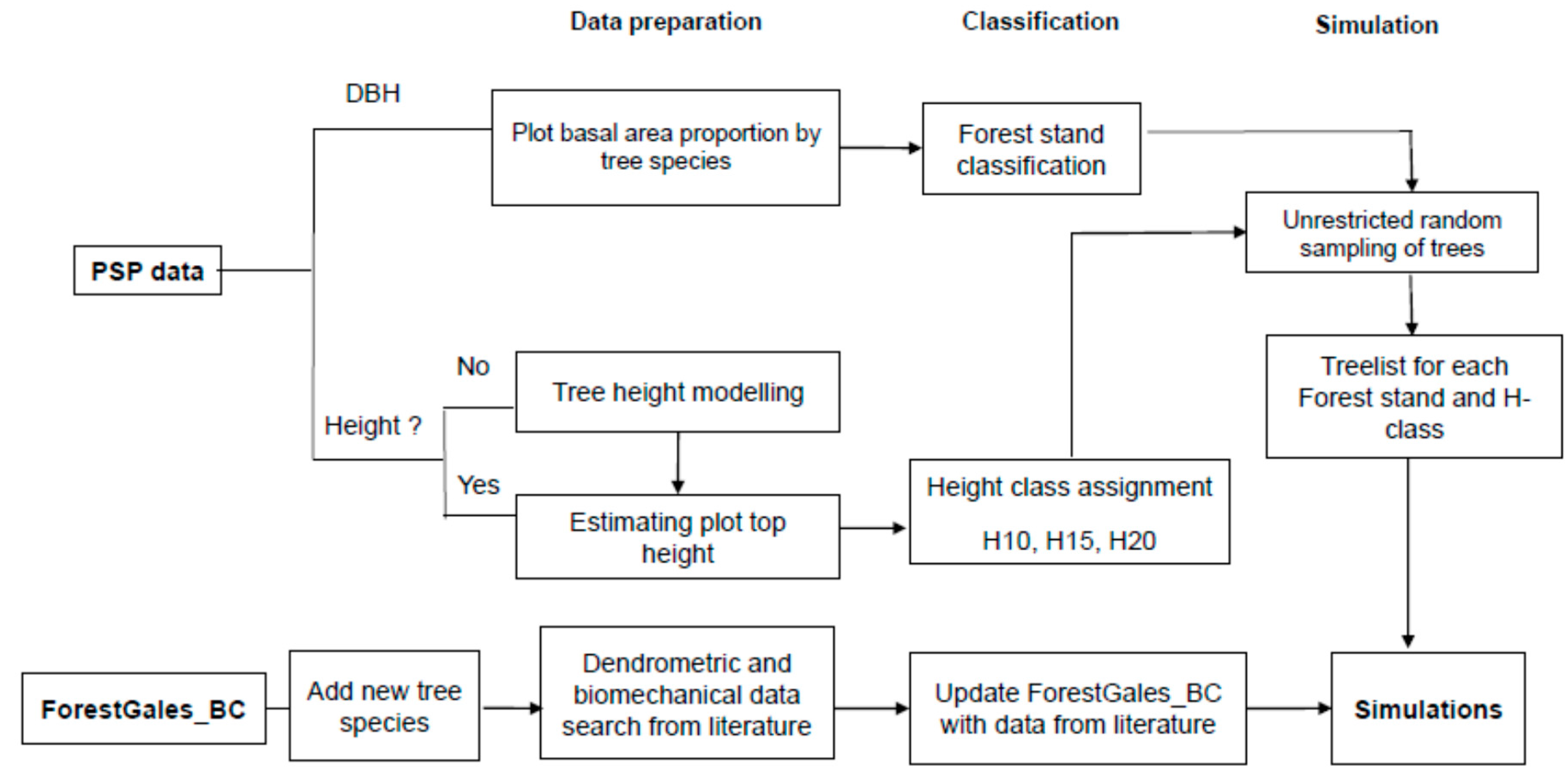
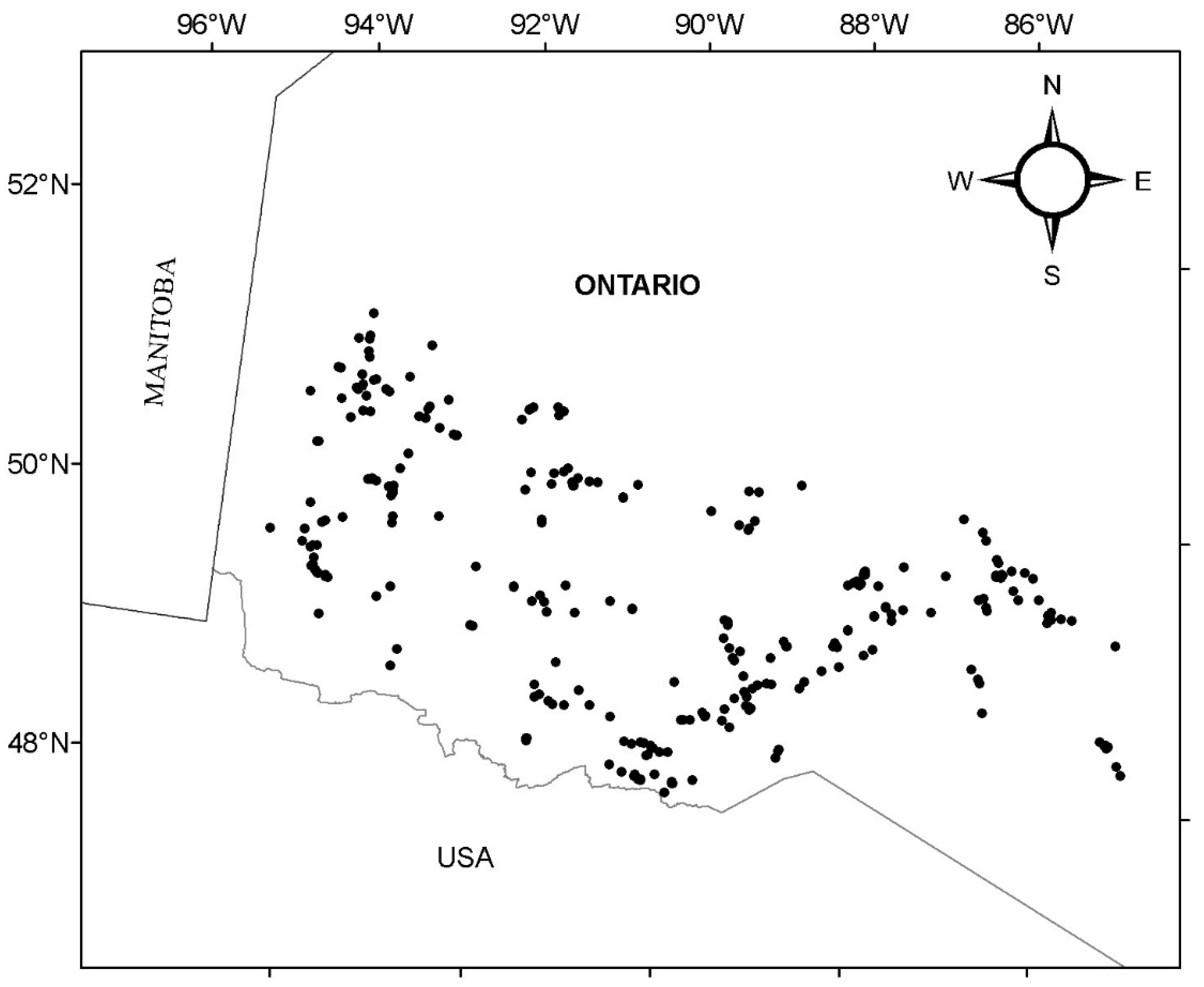
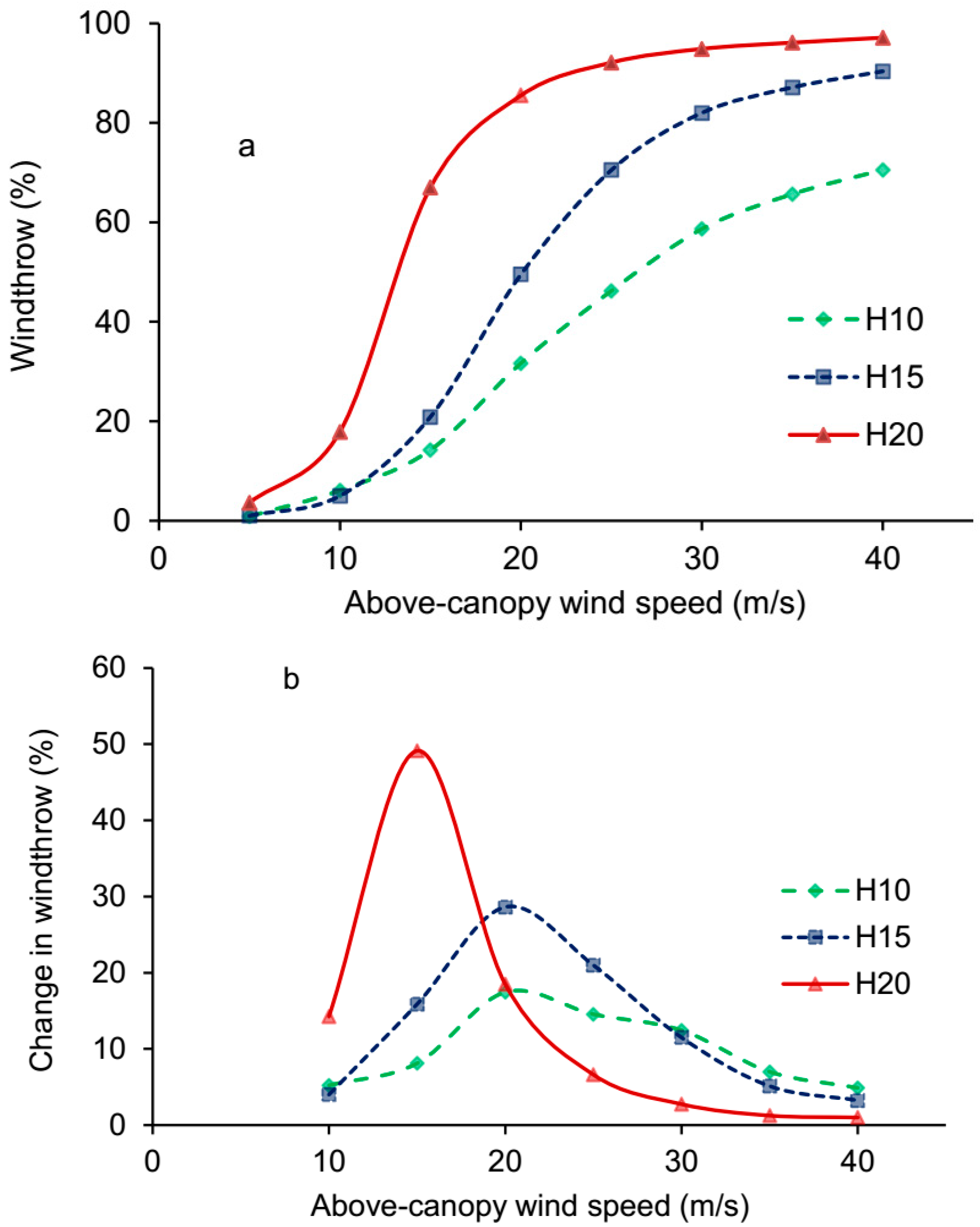
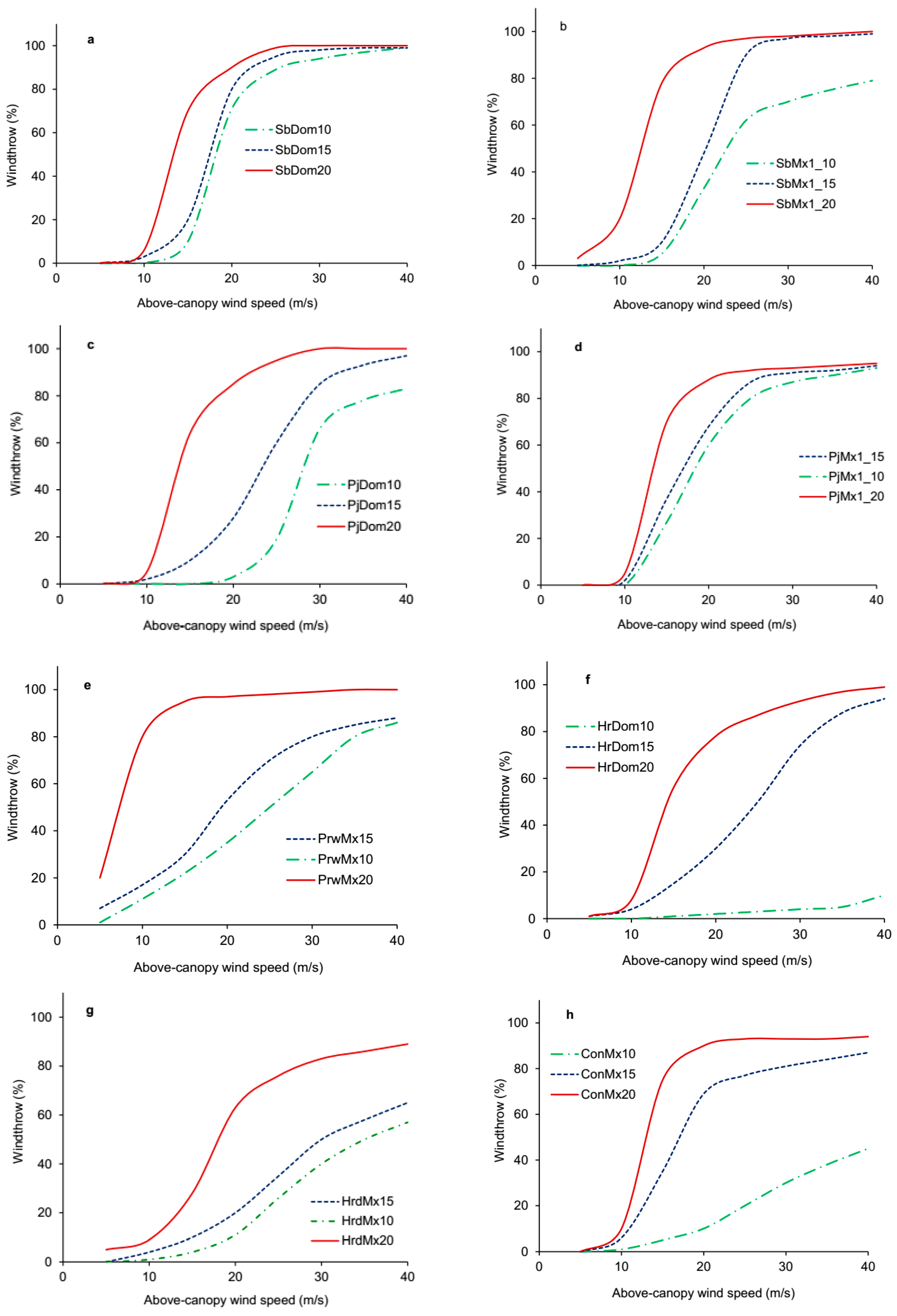
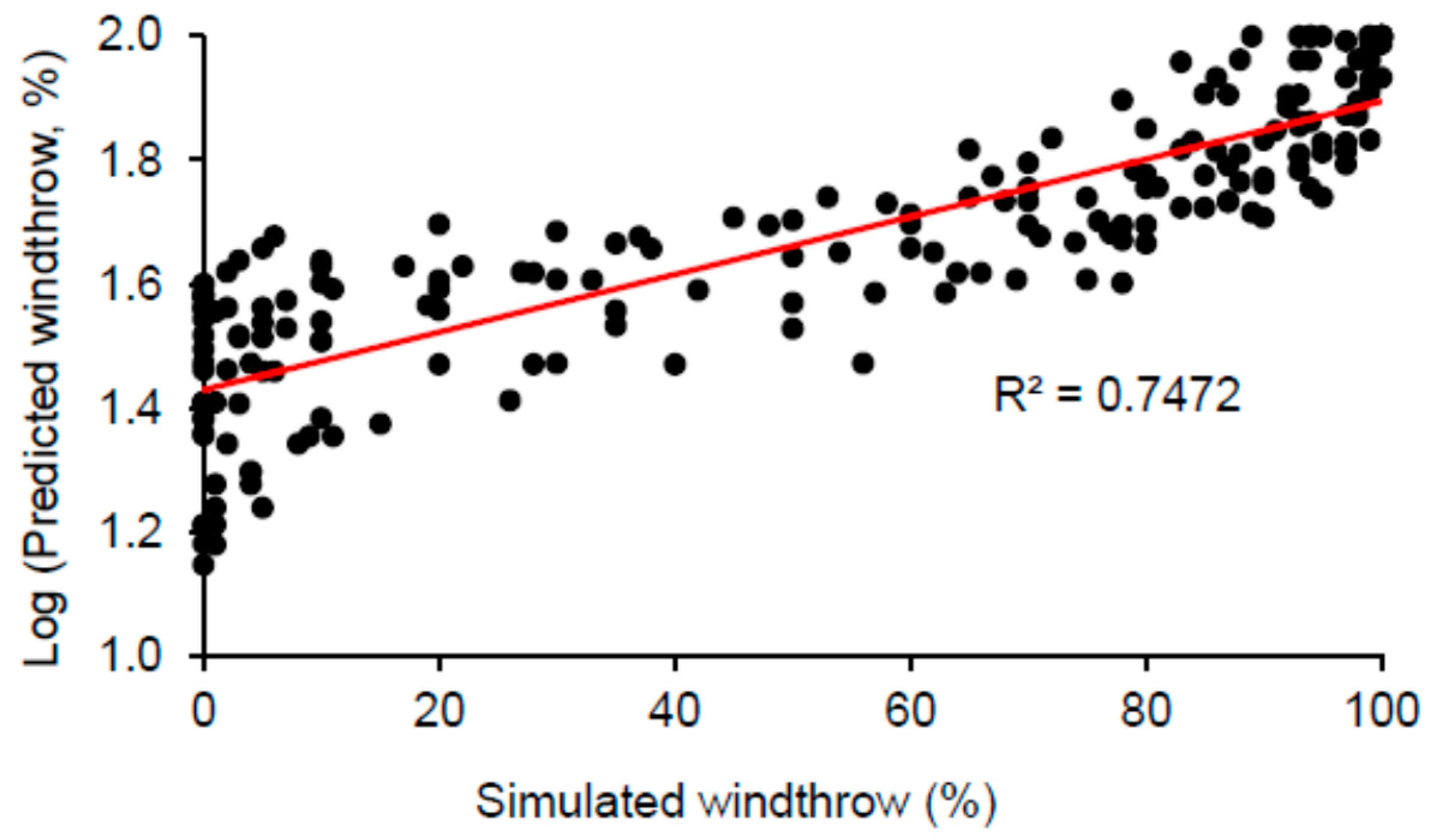
| Name | Designation | Definition |
|---|---|---|
| Balsam fir dominated | BfDom | Balsam fir > 70 |
| Jack pine dominated | PjDom | Jack pine > 70 |
| Jack pine mixed stands | PjMx1 | Red pine + Black spruce + Jack pine + White spruce + Balsam fir ≥ 70 AND Balsam fir ≤ 10 AND Poplar + White birch ≤ 20 AND Black spruce + White spruce < Jack pine |
| Black spruce dominated | SbDom | Black spruce > 70 |
| Spruce mixed species | SbMx1 | Red pine + Black spruce + Jack pine + White spruce + Balsam fir ≥ 70 AND Balsam fir ≤ 10 AND Poplar + White birch ≤ 20 AND Black spruce + White spruce > Jack pine |
| Conifer mixed species | ConMx | White pine + Red pine + Black spruce + White spruce + Balsam fir + Jack pine + White cedar + Larch ≥ 50 |
| Hardwood dominant | HrDom | Trembling aspen + White birch + Red maple + Balsam poplar ≥ 70 |
| Hardwood-mixed species | HrdMx | Poplar + White birch + Red maple + Balsam poplar ≥ 50 |
| Red and White pine mixed species | PrwMx | Red pine + White pine ≥ 40 |
| Stand Type | Height Class | Number of Plots | ||
|---|---|---|---|---|
| H10 | H15 | H20 | ||
| Balsam fir dominated (BfDom) | 6 | 0 | 0 | 6 |
| Jack pine dominated (PjDom) | 122 | 70 | 15 | 207 |
| Jack pine mixed (PjMx1) | 9 | 14 | 4 | 27 |
| Spruce dominated (SbDom) | 87 | 29 | 5 | 121 |
| Spruce mixed (SbMx1) | 23 | 8 | 2 | 33 |
| Conifer mixed (ConMx) | 101 | 21 | 13 | 135 |
| Hardwood dominated (HrDom) | 79 | 43 | 12 | 133 |
| Hardwood-mixed (HrdMx) | 17 | 8 | 8 | 33 |
| Red and White pine (PrwMx) | 12 | 12 | 12 | 36 |
| Total Plots | 456 | 205 | 71 | 731 |
| Source | Degrees of Freedom | Type III Sums of Square | Mean Square | F Value | Pr > F | Variance Explained |
|---|---|---|---|---|---|---|
| Wind speed | 1 | 178,922.04 | 178,922.04 | 555.17 | <0.0001 | 60% |
| Height class | 2 | 39,620.38 | 19,810.19 | 61.47 | <0.0001 | 13% |
| Stand type | 8 | 22,900.97 | 2862.62 | 8.88 | <0.0001 | 8% |
| 81% |
| Stand Type | Designation | α | β |
|---|---|---|---|
| Balsam fir | Bfir | 29.304 | 0.003 |
| Conifer mix | ConMx | 20.377 | 0.002 |
| Hardwood dominant | HrDom | 12.058 | 0.003 |
| Hardwood mix | HrdMx | 13.268 | 0.003 |
| Jack pine dominant | PjDom | 20.106 | 0.002 |
| Jack pine mix | PjMx | 32.013 | 0.002 |
| Red and White pine mix | PrwMx | 32.926 | 0.002 |
| Black spruce dominant | SbDom | 33.209 | 0.002 |
| Spruce mix | SbMx | 26.769 | 0.002 |
| Species | Wind Speed (m/s) | Percent Windthrow Simulated, Min–Max (Average) | Percent Windthrow from Literature | Bias | Reference |
|---|---|---|---|---|---|
| Balsam fir | 25 | 67 | 60 | 7 | [13] # |
| Spruce | >53 | 71–100 (94) | 54.6 (Sb) | 38.2 | [25] |
| >53 | 25.5 (Sw) | [25] | |||
| >20 | 73.2 (Sn) | [26] # | |||
| 33–44 | 70 (Sr) | [27] | |||
| Aspen | >20 | 83–100 (93) | 74.5 | 20.8 | [26] # |
| >53 | 69.9 | [25] | |||
| Birch | 17 | 2–99 (54) | 20 | 18.1 | [28] # |
| >20 | 65.7 | [26] # | |||
| 33–44 | 40 | [27] | |||
| >53 | 17.8 | [25] | |||
| Pine | >53 | 1–99 (49) | 82.4 (Pj) | −15.2 | [25] |
| >53 | 77.1 (Pr) | [25] | |||
| 55 | 33 (Pm) | [29] # | |||
| White cedar | >53 | 10–99 (68) | 12.4 | 55.6 | [25] |
| Larch | 21.1–32.5 | 2–97 (51) | 2 (Le) | 49.7 | [30] # |
| 9 | 4 | 11 (Lk) | [31] | ||
| Overall | 22.8 |
© 2017 by the authors. Licensee MDPI, Basel, Switzerland. This article is an open access article distributed under the terms and conditions of the Creative Commons Attribution (CC BY) license (http://creativecommons.org/licenses/by/4.0/).
Share and Cite
Anyomi, K.A.; Mitchell, S.J.; Perera, A.H.; Ruel, J.-C. Windthrow Dynamics in Boreal Ontario: A Simulation of the Vulnerability of Several Stand Types across a Range of Wind Speeds. Forests 2017, 8, 233. https://doi.org/10.3390/f8070233
Anyomi KA, Mitchell SJ, Perera AH, Ruel J-C. Windthrow Dynamics in Boreal Ontario: A Simulation of the Vulnerability of Several Stand Types across a Range of Wind Speeds. Forests. 2017; 8(7):233. https://doi.org/10.3390/f8070233
Chicago/Turabian StyleAnyomi, Kenneth A., Stephen J. Mitchell, Ajith H. Perera, and Jean-Claude Ruel. 2017. "Windthrow Dynamics in Boreal Ontario: A Simulation of the Vulnerability of Several Stand Types across a Range of Wind Speeds" Forests 8, no. 7: 233. https://doi.org/10.3390/f8070233
APA StyleAnyomi, K. A., Mitchell, S. J., Perera, A. H., & Ruel, J.-C. (2017). Windthrow Dynamics in Boreal Ontario: A Simulation of the Vulnerability of Several Stand Types across a Range of Wind Speeds. Forests, 8(7), 233. https://doi.org/10.3390/f8070233






